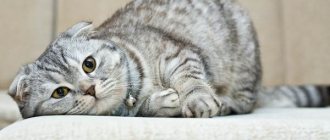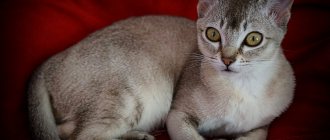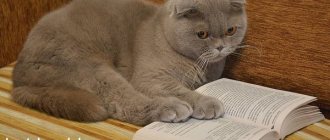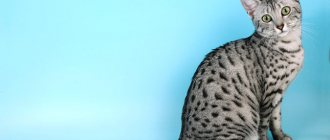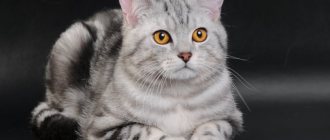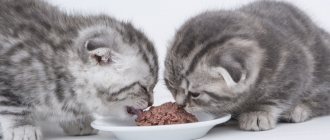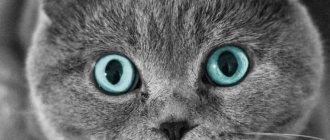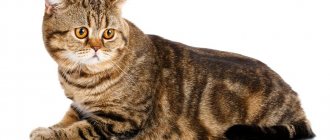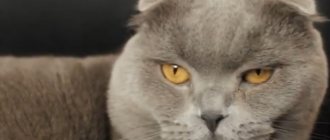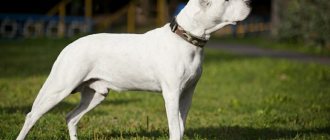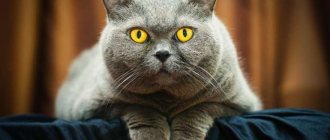When breeding new dog breeds, breeders have long focused on working qualities. Selection based on unusual exterior gained popularity much later, which cannot be said about our beloved “mustaches.”
Thanks to a large number of experiments, breeds of cats with ears bent back have appeared in the world, as well as other, no less original animals with bizarrely shaped ears. Below you can get acquainted with the most famous representatives of this group, and also find out whether they require special care.
Scottish lop-eared
The breed of cats with small ears is the Scottish Fold, very beautiful and friendly animals. They are distinguished by soft plush fur, round large eyes, the Scots are calm and affectionate in character, they play with pleasure with their owner, but they are not overly intrusive.
© shutterstock
The characteristics of the breed are as follows:
- A good indicator of health; with proper care, cats can live more than 15 years.
- Stable psyche.
- Scottish Folds are almost silent and rarely meow.
- The ears, due to their unusual shape, are so small that they are practically invisible.
The breed is suitable for families with children, since cats are very good-natured towards their little owners and enjoy playing with them.
The first representatives of the breed were discovered in Scotland; the ancestor is a simple domestic cat, whose lop ears appeared due to a mutation. After birth, kittens have the usual erect ears, which are quite small, but as the animal grows up, it will acquire its recognizable feature. Not all Scottish fold kittens become fold-eared; in the first weeks, even the breeder cannot predict their future appearance.
In the photo you can see that their ears are pressed to the round head, the body is of medium size, the tail is proportional to it. The coat is dense, plush, but can also be long.
This is interesting: Thai cats - description of the breed and character
Devon Rex and Gherkin Rex
The Devon Rex breed, bred in England, quickly conquered the world. The cats have a nice short, slightly curled coat, with huge ears sometimes topped with tufts.
Expert opinion
Slanimsky Alexey Georgievich
Veterinarian of the highest qualification category. Has extensive experience in diagnosing and treating diseases in animals.
You are unlikely to find a more loyal cat than the Devon Rex. Cats of this breed are very smart, easily learn commands, and cases have been recorded of Devon Rex protecting their owners.
In their behavior, Devons and Cornishes are the epitome of aristocracy: they do not steal food from the table, they are instantly litter-trained, they are as clean as possible, they are not vengeful and do not bite. They can be easily walked on a leash and experience virtually no stress when traveling or moving.
Unrecognized breeds of shorthair cats
In order for a breed to be registered in felinological systems, four generations of stable individuals must be born, numerous exhibitions must be held, and its standard must be written and accepted by leading experts.
Many lines are initially approved as "experimental". Thus, four generations of many hybrid cats have not yet been obtained, but these breeds already exist, for example, Caracat.
There are also cats in the world that are considered unrecognized today. Work on selection is either currently underway or has been postponed for one reason or another. Some of them are very interesting.
Aegean
Ancient natural species from the Cyclades Islands in the Aegean Sea. Carefully cultivated by Greek breeders, but practically unknown outside its homeland.
About Aegean cats on our website.
Dutch Rex
Amazing kittens with coarse, curly hair were born to purebred Maine Coons in Holland in 1985. For now, selection has been suspended, but cases of the birth of such babies are periodically recorded by breeders.
Cats of Saint Helena
This is a natural view from the island of Cyprus. Two types are defined: St. Helena and Aphrodite. According to legend, these animals came to the island during difficult times of famine and drought on the orders of Empress Helena, mother of Constantine the Great, ruler of Jerusalem, to fight snakes.
Cohona
“Naked, naked” is how the name of the breed is translated from the Hawaiian language. The cat was born completely bald as a result of a natural mutation. Currently, about fifty of these individuals are registered.
Likoy
Strange kittens were born in 2010 in Virginia as a result of a natural genetic mutation. Sparse hair, complete absence of undercoat, hairless ears and roan coloring do not make these animals particularly cute. But the kids have a wonderful character.
They got their name because of their resemblance to the werewolf of the same name from horror films. Translated from Greek it means “wolf”.
Bambob
Obtained in the United States of America by crossing the Bambino and the American Bobtail and Sphynx mix. In addition to a bald body and short legs, it also has a small tail (tailless). Work on the breed continues.
Bramble
Obtained in the USA by crossing Bengal and Peterbald. Currently registered in the register of exotic and rare breeds.
Bristol
A hybrid of the very rare wild Margay (long-tailed cat) and the American Shorthair. They are very few in number, so they are still considered an experimental breed.
Dwelf
Bald dwarfs with curled ears, like curls. The result of crossing a Munchkin, a Sphinx and an American Curl.
Small ears are the key to great happiness
Scottish cats are becoming increasingly popular among cat lovers, and for very pragmatic reasons. Exotic cats are most often artificially bred, which means they are susceptible to various diseases and require special care and nutrition. In the modern rhythm of a huge metropolis, it is difficult to provide your pet with proper care and attention, so people choose animals as pets that optimally maintain a balance between beauty and unpretentiousness.
Scots are omnivores, and thanks to their soft mouton coat, they tolerate the Russian climate well - when it is hot and drafty in summer, and in winter the air is very dry due to central heating. There are widespread rumors that due to the specific structure of the ears, these cats often have hearing problems and other diseases. But veterinarians and breeders say this is a myth. Scottish cats hear perfectly and do not suffer from any deviations, except for funny curved ears.
In 1961, farmer William Ross came across a white kitten with funny ears on his estate. Fortunately, William was a true connoisseur and lover of animals, he registered the grown-up cat Susie with the GCCF of Great Britain (the register of cat breeds of the United Kingdom) and began breeding fold-eared kittens. Later, professional geneticists took over his work.
By the way, the ears of the first cat, Suzy, were bent just a little with a strong tilt forward, but now show-class cats have ears that fit tightly, and sometimes are not noticeable at all, this effect was achieved as a result of complex selection.
Unfortunately, later the BCF (British Cat Fancy) thought that breeding animals artificially was not entirely humane, and Scottish Folds can have various diseases, and the breed was excluded from the list of registered ones. Thus, this breed is not recognized in England and Europe, but is nevertheless popular throughout the world.
Scots are often confused with British cats, despite the fact that for an experienced specialist they are also not similar, as for us Persian and Sphynx cats are. It’s just that during the selection process, folds were crossed with the British and exotics in order to achieve more characteristic characteristics of the breed, as well as stable color and fixation of the ears.
Today only fold-eared kittens are allowed to exhibit, but except for their ears, they do not differ from their relatives - the same fur, the same eyes, the same character. But straights, despite the doom of their show career, are very important for breeding. You cannot cross two folds, because this will lead to congenital skeletal defects in the offspring. The ideal husband and wife are straight and fold.
Its peaceful disposition makes this breed a true family pet. Forums of breeders and owners are full of messages about wonderful love and friendship between small children and fold-eared cats. A real fluffy pillow and a purring hot water bottle - these are the epithets used to describe the Scottish.
But your pet will not differ in intelligence. No, he can easily learn how to open the refrigerator with his paw or what time you come home. But your pet is unlikely to be a hunter, a guard, or a threat to the neighbors’ cats.
If you decide to breed this breed, then you will give birth together with the Fold. So if your pet is pregnant, read in advance how to deliver a cat or keep the veterinary emergency phone number in a visible place. It doesn’t happen once in a while, but if you’re forewarned, you’re forearmed!
Despite such minor disadvantages, Scottish Fold cats are optimally adapted to living with people. Such a cat respects and values both its personal space and its owners. And without difficulty he will become the warm and charming pride of the house and a friend of each family member.
Source
Hairless cats
Hairless cats, although called hairless, actually have either an undercoat or sparse main hair.
Single specimens are born completely without hair, with amazing “rubber” or “rubber” skin.
In all systems, hairless cats belong to the “short-haired” group.
Canadian Sphynx
Registered in 1966. The first hairless kitten was born in the litter of a normal forest female in Canada. Amazing creatures with warm and pleasant to the touch skin can be of different colors.
Read about the Canadian Sphynxes.
Bambino
Obtained by crossing Canadian Sphynxes and Munchkins. Registered so far only in the American TICA system already in the twenty-first century. A bald animal on the short legs of a munchkin. But a litter may also contain kittens with long legs.
Don Sphynx
This is a Russian breed. Launched in 1987 in Rostov-on-Don. Amazing animals are the descendants of a strange stray kitten with sparse, at first glance, hair that has come out. He turned out to be not sick, but a carrier of a mutant gene. They have an elevated body temperature, about forty-two degrees Celsius. There are different color combinations of leather available.
Read the article about Don Sphynx dogs. And also about how they differ from Canadian ones.
Peterbald
This is a Sphynx born in St. Petersburg, from the Don Sphynx and the Oriental cat. Registered in 1997. Different color variations are acceptable. Read about Peterbalds.
How many furry breeds are recognized by FIFe, WCF, CFA
There are three world organizations that assign official statuses to various newly developed cat breeds: FIFe, WCF and CFA. The number of breeds that have been registered by the relevant organizations is distributed as follows:
- The World Cat Organization (WCF) has legitimized about 70 breeds.
- There are 42 breeds registered by the International Cat Organization (FIFe).
- About 40 cat breeds have received official status from the Cat Fanciers Association (CFA).
Typically, the data is constantly updated as some breeds are repeated, although called differently, and some breeds are developed and added to the list from time to time.
Important point! The third part (31 breeds) of long-haired cats are distinguished by the fact that they have their own standard, therefore they have permission both for breeding work and for exhibition shows.
Origin story
The domestic cat is a companion animal that has lived alongside humans for over ten thousand years.
The first wave of its spread around the world occurred with the emergence of agriculture, twelve thousand years ago, mainly in the Middle East. The second contributed to the settlement of cats that migrated with humans from Egypt to Europe and North Africa.
The first wild animal, from which our pets originated, appeared on the planet more than 130 thousand years ago. This is a steppe cat that still lives in Africa.
The first pets most likely appeared in Anatolia - the territory of modern Turkey. Their appearance near humans is associated with the development of agriculture, the availability of food in sufficient quantities and the need to protect supplies from rodents and small predators. It was from the east that the companion animal came to Cyprus and Ancient Egypt.
Scientists have differing opinions about whether cats are fully domesticated animals or not. This independent animal is capable of returning to the wild at any time. Unlike the dog, which lost its hunting skills during evolution, the blood of the ancient ancestors in the cat is very strong.
This is a friend, companion, and sometimes assistant and protector, he simply lives nearby and allows himself to be loved. Whether a person has tamed a cat or whether it has taken his heart and soul and holds it in her tender claws is a difficult question.
Over centuries of coexistence, people deified and worshiped the cat. And now they continue to serve her. However, these smartest creatures respond to people with no less love and affection.
Initially, starting with the wild steppe cat, these animals were only short-haired. The long hair of many breeds is the result of natural or artificial mutations.
But many representatives of the cat world today are short-haired and delight the aesthetic sense with their shiny coat of various quality and colors.
Read the article about the forest cat, the true ancestor of our domestic cats.
Persian
A cat with erect ears of small size is a Persian, a very beautiful breed, the history of whose origin has not yet been definitively revealed. Some scientists attribute to her a family connection with steppe cats, wild inhabitants of Asia, others believe that the direct ancestor of the Persians is the Pallas cat, which is also characterized by miniature ears. The distinctive features of the breed are :
- The body is large, with low legs, a muscular chest and developed shoulders.
- Medium sized fluffy tail.
- Wide set ears.
- Small snub nose.
- The average weight of an adult animal is about 7 kg.
- The coat is very long, more than 10 cm, thick but thin. A tuft of hair is most often present between the claws.
The owner of such a beautiful animal should prepare himself for daily care of long hair, otherwise it will mat and the cat will look sloppy. However, as an alternative, you could consider purchasing an Exotic Persian, an attractive breed with a soft, plush, short coat.
© shutterstock
This is interesting: Which drops are best for kittens against fleas
American Curl
Another wonderful breed of cat with small ears is called the American Curl. These are very peaceful creatures with thick fur, which can be either long or short. Cats are easy to train, can walk with their owner on a leash, are active and love to play. A distinctive feature is that the ears are small with tassels, which makes the cat’s appearance recognizable.
In the photo you can see that representatives of the breed have ears that bend outward. Therefore, the animal itself looks quite cheerful and unusual, and at the same time the animal’s character is very flexible, they get along well with children, are unobtrusive, but enjoy playing with the owner.
The following features of the appearance of curls can be identified::
- A lean, muscular body of medium size with a powerful chest and strong limbs.
- Wedge-shaped head.
- Large oval eyes, acceptable colors - green, blue, golden.
- Silky fine coat with slight undercoat.
These cats will become true friends for many years, but their big drawback is that their ears need to be looked after very carefully. They are very curious, get along well with other pets, and get along with children.
Cats with small ears are amazingly cute and cute creatures that will improve the owner's mood every day with their funny antics.
Previous
Questions and AnswersCats with round ears - list and description of breeds
Next
Questions and answersMultifel 4 for cats - instructions for use
Cats with small ears: Breed and its characteristics
Most breeds have standard ears. Medium-sized or slightly pointed, some even have graceful tassels that resemble their wild brothers. The Siamese-Oriental group are famous for their large ears .
Cats with small ears are mostly artificially bred and, in addition to the fact that the ears are small, they also have a bend outward or inward.
The main representatives of miniature ears:
- Highland Straight and Scottish Fold. Two representatives of Scottish cats. They differ mainly in the length of their coat.
- Ukrainian Levkoy. Very similar to the sphinx, also lacking fur. But the ears are smaller and the tips are curved forward.
Other breeds may also have small ears, but this is often considered a defect.
To enlarge the picture, click on it
Do these pets need special care?
Basically, the recommendations depend not on the shape of the ears, but on the individual characteristics of the body:
- Lack of wool.
Sphynxes, Ukrainian Levkoy, Dwelf, Elf and Bambino require more comfortable temperature conditions. They quickly burn in the sun and constantly freeze in winter. For this reason, they should be covered with sunscreen and dressed in warm clothing. Dirt and sweat also accumulate on the skin of naked people very quickly. To avoid unpleasant odor and brown plaque, they should be washed once every 1-2 weeks.
- Long wool.
The Maine Coon and the semi-longhaired variety of the American Curl shed heavily. Without regular brushing, their fur becomes tangled and can lead to dermatitis.
- High activity.
Savannahs not only require a lot of food, but also a lot of outdoor exercise. Constant confinement within four walls can worsen their health.
If we talk specifically about the ears, then we have 2 options: curved and very large. In both cases (with the exception of the ears bent back), dirt, dust and sulfur quickly accumulate inside.
Without frequent cleaning, all this secretion attracts pathogenic microorganisms and contributes to the development of ear diseases. To prevent them, it is necessary to remove accumulated dirt every 5-7 days using special products or a cotton pad soaked in warm water or olive oil.
Do you like the article? 0
Cat with small ears: Breed. Where can I buy?
If you still want to buy a cat with small ears, then you must first read the literature , which describes the nature of a particular breed, the features of its maintenance and care.
It is important to know what to feed your cat and what preventive procedures need to be carried out, what diseases they are most susceptible to.
For your peace of mind and the future health of your cat, you need to choose a place where to buy a kitten. There are several options:
- Virtual trading platforms (Avito, Yula, etc.). Kittens are sold here mostly cheaply, offering animals without documents or vaccinations. Not a very good option, since you are literally buying a pig in a poke.
- Bird markets. The same as online services, only due to crowded conditions the kitten can become infected.
- Pet Shop. Option if there is proper documentation of origin and vaccination.
- From friends. The right place if you trust them completely.
- In the nursery . The best option. The kitten's parents must be healthy, with documents confirming their origin and vaccination. The baby should have all this too. As a rule, kittens from reputable nurseries are more expensive and are not sold earlier than three months, before vaccinations.
The main differences between purebred pets and domestic ones
Scientists have proven that domestic cats have a common ancestor - the steppe cat, which still lives in North Africa . About 200 cat breeds have been registered by felinological organizations. All of them are the result of painstaking work of breeders and have clear standards. The shape of the head, muzzle, eyes, ears, length of fur, limbs, tail, body, color and character are taken into account.
Pedigree cats have documents that confirm their belonging to the breed . They record the names of its three generations and color features. The meaning of an animal's thoroughbred is that when purchasing, the owner will know exactly what character the animal has, what health nuances need to be paid attention to, and how to care for it.
For example , the Siamese cat is known for its loud meowing and vindictiveness, based on this, the future owner knows what he will have to face. Sphynx cats require special skin care and nutritional control due to their excessive appetite.
There are mixed breeds of cats with a whole bunch of genetic pathologies, but at the same time they have an attractive appearance and an easy-going disposition. All this must be taken into account when choosing a kitten - the necessary information can be obtained from the owner of the nursery. This is why experts advise contacting specialized nurseries so as not to literally buy a “pig in a poke.”
If you come across a baby not from a nursery, but, say, it was given to you as a gift, or you picked it up on the street, you can try to determine the breed yourself. To find out what breed a cat is, you need to carefully examine the animal, determine its striking features , and then study the appropriate breed standard.
